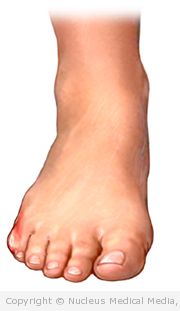Calluses and corns – Definition
A callus is an abnormal thickening of the top layer of skin, which is composed of the natural protein, keratin. Calluses can form on areas that are repeatedly exposed to friction or pressure. They are usually painless or only mildly painful.
A corn is a small, thickened area of skin that forms on the toes. Corns put pressure on the underlying skin against the bone. They are usually painful.
Calluses and corns – Causes
Calluses and corns form as protective pads of skin in response to repeated friction or pressure. Causes include:
- Calluses — Any activity that applies repeated friction or pressure to an area of skin, including:
- Lifting weights (hands)
- Using tools (hands)
- Playing a stringed instrument (hands)
- Running long distances (feet)
- Kneeling to lay carpet or tile (knees)
- Walking on hard surfaces without shoes (feet)
- Corns — Any activity or condition that applies repeated friction or pressure to the toes, including:
- Wearing ill-fitting shoes
- Bunching of socks around toes
- Socks with seams that rub against the toes
- Foot abnormality causing a protrusion that rubs against footwear
Calluses and corns – Risk Factors
Factors that may increase the risk of calluses and corns include:
- Professions or physical activities that cause repeated friction or pressure on the skin
- Wearing ill-fitting footwear
Calluses and corns – Symptoms
Symptoms of calluses include:
- Rough, thickened area of skin
- Painless or slight degree of pain, burning sensation
Yellow or reddish in color
- Symptoms of corns include:
- Small, usually painful bump on the side, on the top, or between toes
- Yellow or reddish in color
Calluses and corns – Diagnosis
The doctor will examine the skin where a corn or callus has formed. Diagnosis is based on symptoms and visual observation of the corn or callus. They are easily distinguished by:
- Location — Corns usually only form on or between the toes.
- Degree of pain — Corns are usually quite painful, while calluses are usually painless or only slightly painful.
The doctor may need to use a scalpel to reveal the layers of the skin growth to make sure that it is a corn or callus, rather than a wart.
Calluses and corns – Treatment
Treatment of calluses and corns usually includes self-care and medication. In severe cases, minor surgery may be necessary. People with diabetes or circulatory problems should always see a medical doctor or podiatrist for treatment. Self-treatment may lead to severe infection in these individuals.
Self-Care
For calluses:
- Wear gloves, thick socks, or padding to protect skin.
- Thin the callus by rubbing with a pumice stone while bathing.
For corns:
- Wear properly fitting shoes.
- Remove bunching of socks, irritating stitching from socks, or any other irritant.
- Thin the callus by rubbing with a pumice stone while bathing.
- Try using doughnut-shaped corn pads, which may relieve pressure on corns.
Medication
Applying keratin-dissolving medication (such as salicylic acid) can help dissolve calluses and corns more quickly. Apply medicine carefully because it contains acid that may damage nearby healthy skin.
Minor Surgery
In severe cases, calluses and corns may need to be shaved off with a scalpel by a doctor. More extensive surgery may be needed to correct foot deformities that cause extremely painful or debilitating corns.
If you are diagnosed as having a callus or corn, follow your doctor’s instructions.
Calluses and corns – Prevention
To prevent calluses:
- Avoid activities that apply repeated friction or pressure to the skin.
- Wear gloves, thick socks, or padding over the affected area of the skin.
To prevent corns:
- Wear properly fitted shoes.
- Wear properly fitted socks with no irritating stitching.

